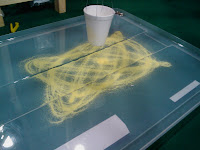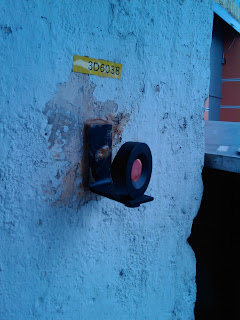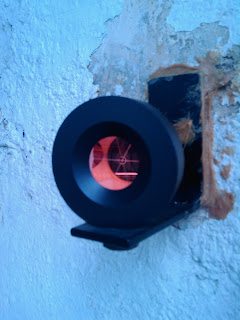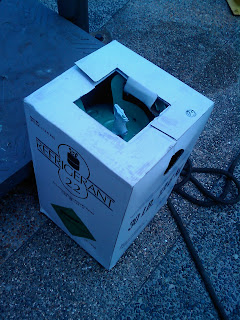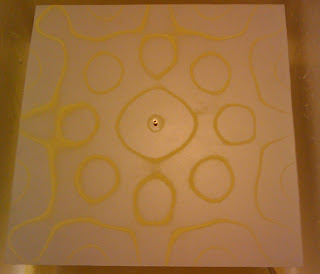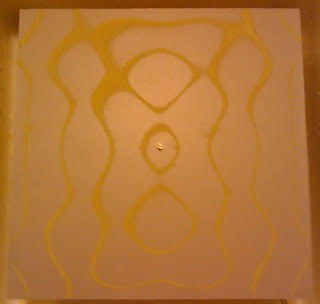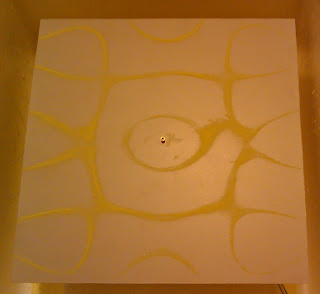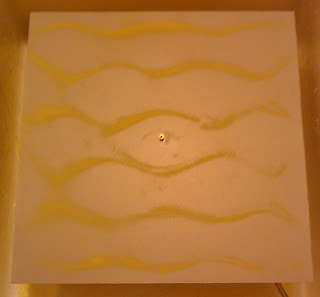Ever since I first read of them in junior college, I have always found Lissajous figures mesmerizing and beautiful.
I found a simple way to create them without using two function generators (poor me; I could only afford one) by using the left and right audio channels of a laptop.
You can also create them in sand! This is a hands-on experiment I did at a science camp; needless to say, the kids loved messing around with it.
The Liberal Arts Tutor
The working blog of Ben Tang, the liberal arts tutor.
Monday, February 7, 2011
Physics : Corner cube reflectors
This is a corner reflector used by surveyors to measure distances precisely by bouncing lasers off them. [Link to Wikipedia article]. Read up on how they work; their operation is relevant to total internal reflection and prisms in O&A-level physics.
This particular reflector was near bar named "The Colonial" above Little India Station on the underground NEL line. They can also be found on almost all the pillars that support the elevated sections of old East-west and North-south MRT lines.
The coolest thing about these reflectors is that the Apollo astronauts left a panel of them on the moon. [Link to Wikipedia Article] I really think it is ridiculous that anyone should doubt that men have been to the moon, especially when observatories around the world bounce lasers off those reflectors to measure the distance to the moon. Don't try using your laser pointers; the power needed to reach the moon is in the neighbourhood of a hundred watts, and even then, only a few photons get reflected by the corner reflectors and make it back to earth!
This particular reflector was near bar named "The Colonial" above Little India Station on the underground NEL line. They can also be found on almost all the pillars that support the elevated sections of old East-west and North-south MRT lines.
The coolest thing about these reflectors is that the Apollo astronauts left a panel of them on the moon. [Link to Wikipedia Article] I really think it is ridiculous that anyone should doubt that men have been to the moon, especially when observatories around the world bounce lasers off those reflectors to measure the distance to the moon. Don't try using your laser pointers; the power needed to reach the moon is in the neighbourhood of a hundred watts, and even then, only a few photons get reflected by the corner reflectors and make it back to earth!
Chemistry : Air conditioner refrigerant fluids
This is a photograph of a tank of refrigerant fluid used by a repairman to recharge old air conditioners and refrigerators.
The liquified gas in the tank is Chlorodifluoromethane [Link to wikipedia article] which is a formed by allowing chlorine and fluorine atoms to replace hydrogen atoms in the methane molecule in a textbook reaction known as substitution.
The liquified gas in the tank is Chlorodifluoromethane [Link to wikipedia article] which is a formed by allowing chlorine and fluorine atoms to replace hydrogen atoms in the methane molecule in a textbook reaction known as substitution.
Friday, February 4, 2011
GP Essay : The language of mathematics is the perfect language. Do you agree?
This essay topic is not an easy one to write on.
A student of mine posed this topic to me as a friendly challenge which I was glad to take on.
I might not have done as great a job on this as I would have liked but this represents my best efforts.
I was not time constrained; I took about 4 hours to write this in two sittings.
Click here for the essay:
The language of mathematics is the perfect language. Do you agree?
A student of mine posed this topic to me as a friendly challenge which I was glad to take on.
I might not have done as great a job on this as I would have liked but this represents my best efforts.
I was not time constrained; I took about 4 hours to write this in two sittings.
Click here for the essay:
The language of mathematics is the perfect language. Do you agree?
Physics : Trebuchet
Built this trebuchet in 2009 in preparation of a science camp. Didn't get to use it, but still hope to do so in a camp sometime soon. Test fired it; needs refinements on the release mechanism.
Great demo for conversion of energy. Definitely quite fun to setup and fire. Use tennis balls as ammo, but ideally something heavier should be swung on this although safety concerns would kick in. I think water bombs make a good ammo too.
Great demo for conversion of energy. Definitely quite fun to setup and fire. Use tennis balls as ammo, but ideally something heavier should be swung on this although safety concerns would kick in. I think water bombs make a good ammo too.
Physics : Chladni Patterns
Chladni patterns are a really cool way to visualize standing waves.
For more info on the man and the field he helped pioneer:
Ernst Chladni on Wikipedia
Cymatics on Wikipedia
I rigged a speaker to an amplifier and a frequency generator. The speaker was modified such that the cone directly drives a square metal plate. Yellow art sand was added and when certain frequencies were dialed into the frequency generator, the sand would quickly coalesce to form patterns.
More details on setup will be posted here. I'm still working on it at the moment.
Meanwhile, enjoy the pictures!
For more info on the man and the field he helped pioneer:
Ernst Chladni on Wikipedia
Cymatics on Wikipedia
I rigged a speaker to an amplifier and a frequency generator. The speaker was modified such that the cone directly drives a square metal plate. Yellow art sand was added and when certain frequencies were dialed into the frequency generator, the sand would quickly coalesce to form patterns.
More details on setup will be posted here. I'm still working on it at the moment.
Meanwhile, enjoy the pictures!
Thursday, February 3, 2011
GP Essay : Music has one purpose – to entertain
I wrote this GP essay some time ago for one of my students.
Makes for an interesting read; not the regular current affair GP essay question.
Click here for the essay:
Subscribe to:
Posts (Atom)

